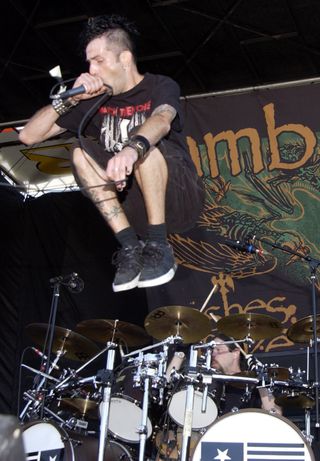From modest beginnings at Virginia Commonwealth University in 1990, Lamb Of God have become one of the most crucial and acknowledged metal names of the 21st Century.
The story begins with guitarist Mark Morton, bassist John Campbell and drummer Chris Adler. Living in the same dormitory at the aforementioned university, the three started an essentially instrumental band.
“It wasn’t like we’d known each other for ages,” explains Morton. “We just got together, and felt we were all coming from the same place, musically. But just because we were an instrumental band, don’t think we were playing prog rock. From the start, the band was called Burn The Priest, and that really tells you we were hard, aggressive and very heavy.”
“You have to understand that we were based in Richmond, Virginia, at the time,” adds Adler. “And the biggest metal band ever to come out of there were GWAR. It was a very insular musical community, where bands didn’t look to the national picture, let alone the international one. We just got in with playing weird music and trying out different ideas. In a lot of ways, it was so refreshing.”
After graduation, Morton temporarily quit to pursue post-graduate studies – International Relations – up in Chicago. But Campbell and Adler decided to take their music to another level, bringing in guitarist Abe Spear and vocalist Randy Blythe.
- Lamb Of God rank their albums from worst to best
- Lamb Of God: how we wrote Laid To Rest
- The Top 10 Best Lamb Of God Songs
- Lamb Of God: the resurrection of Randy Blythe
“When Mark left, neither John nor I felt it should be the end of the band,” reveals Adler. “Our little project had some momentum going. So we brought in Abe. Now, I have to admit that we never wanted a vocalist – at all. But Abe knew this guy called Randy Blythe, and brought him along to scream over some of our instrumental stuff. We never asked him to join the band. He kinda stayed.”
But for Morton, the lure of playing with his old friends was too great. Two years after leaving the band, he quit his Masters degree course, and went home.
“I always had an open invitation to re-join, and to be honest my sole motivation on going to Chicago was to find other musicians to stretch my talents. When that didn’t happen, I wanted to go back and play with my old pals.”
By this time, Spear was a crucial part of Burn The Priest, so the flock was expanded to a five-piece for the release of their self-titled album in 1998 on the Philadelphia-based Legion label.
“We had about four days to record the whole album,” says Morton. “Several songs were actually written at the time when we were just an instrumental band, which tells you what sort of band we always were. I know some people refer to Burn The Priest as mathcore, and we did take some influences from the likes of Confessor, who were mathy. But we also had other things going on.”
Perhaps the most crucial fact about Burn The Priest is that it introduced the fledgling firebrands to Today Is The Day main man Steve Austin, who produced by this record and the subsequent New American Gospel.

“It was Randy’s idea,” laughs Adler. “He was a big fan, phoned Steve up, and he agreed to work within our meagre budget. Steve wasn’t my choice at all. I wanted someone like Alex Perialas, who had worked with Testament. Instead we got this crusty punk, and recorded in his house – Austin Enterprises Studio, in Clinton, Massachusetts. But he was a revelation, working harder than some of the band; we got on so well with Steve that he was the obvious choice next time around.”
There were to be two major shifts in the band before the second album hit the ground running. Firstly, a name change…
“That was our idea,” says Morton. “Think about it, Burn The Priest sounds like the sort of thing a bunch of kids would come up with after drinking too much beer in a basement, which is how we got it in the first place. But can you really take any band with that name seriously? It’s so juvenile. By this time, we were starting to step everything up. At that point, we’d sign to the Prosthetic label, and they were desperate for us to keep on as Burn The Priest. Just because we had a buzz building. But we resisted, told them we were going for Lamb Of God. They seemed happy enough.”
The other change was the departure of Abe Spear. “The truth is that Abe had a photography business, and as the band demanded more attention, he had a choice to make,” says Chris Adler. “Simple as that. When you’re in a band at the level we’d reached back then, you were getting a lot of gigs, but losing money on every one. Now, Abe had been an important part of what we did, to the point that when Mark wanted to come back, we asked Abe if he was happy with that. But, no disrespect to him, bringing my brother Willie into the band increased our potential, and opened us up musically to so many great possibilities.”
The newly smelted Lamb Of God headed back to Steve Austin’s coop in April, 2000, to record what has become a landmark album, New American Gospel.
“I don’t even know if we used up all seven days in the sudio,” admits Morton. “The budget was $5,000, which was very small, but again Steve worked miracles for us in there.”
“We had really come on as a band,” adds Adler. “There was a progressive speed metal thing going on, and the whole album does have a real magic. It’s a very dark record I guess, certainly lyrically. That’s because Randy had a lot to get off his chest. I also feel you can hear a real mania in the way that we would play back then.”
Two songs, in particular, refer to incidents that scarred, or certainly shaped, Blythe. Firstly, there’s Terror And Hubris In The House Of Frank Pollard…
“Yeah, that is a real person,” smirks Morton. “It’s a friend of Randy’s out in Chicago, and I believe the song has to do with a crazy night at Frank’s house.”
The other is the more enigmatic O.D.H.G.A.B.F.E..
“Wanna know what that means?” enquires Morton. “It’s Officer Dick Head Gets A Black Fucking Eye. It’s all based on a time when Randy was beaten up by the cops in San Francisco. He and I were messing around one night, and this idea of Officer Dick Head just came out, and seemed perfect.”
The album was also fuelled, according to legend, by a raging thirst, with many trips down to the local supermarket to stock up on the brews. Morton recalls those times with a mix of humour and slight horror.

“Thankfully, we’ve calmed down a lot since those days! But, yes, we were drunk a lot of the time. I guess it was fortunate that the studio budget had already been paid to Steve, otherwise… we might have found some use for it. I think that’s why the album sounds so reckless at times. In fact, if you listen carefully you’ll hear the results of all that drinking in the mix. When the album was re-issued and re-mixed, I got the chance to hear Randy’s dry vocals, and seriously, there are moments when his wallet chain is definitely rattling! But it’s part of what gives New American Gospel a special quality.”
Originally released in September 2000, the album is regarded as a defining moment in the rise of what’s been described by many as as The New Wave Of American Metal…
“We didn’t know at the time that we were making history,” says Adler. “We never even saw ourselves as part of a movement. That’s the type of thing you guys in the media invent! But when I look back now, I am so proud of what we did. There is a definite spark about the record. Some of it was born out of frustration and panic. But I can still directly relate to the songs. Whenever I hear them, I am transported back to those times, and the same feeling come out again. With the aid of modern technology, could we do a better job with the album now? No way. It’s about capturing the moment, a spirit. New American Gospel sounds exactly as it was meant to be.”
There’s little doubt that this album is among the landmark metal releases of the past several years. It helped shape a career and define a genre. It was re-issued in 2006. How does Adler feel about that?
“It had been completely left up to me , then it would never have happened. I don’t believe in going back and digging up the past. However, we don’t own the record, and Prosthetic were kind enough to tell us they were doing it, and even asked if we wanted to get involved. They didn’t need to, and I respect them for doing that.”
The new record not only re-mastered versions of the classics, but also demos of three songs: New Willennium – which became The Black Dahlia – Half Lid – which metamorphosed into A Warning – and Flux – the original title for Pariah. There’s also Nippon, which was only previously available on the Japanese pressing of the record.
- Loudest Bluetooth speakers: the best speakers for maximum noise
- Less noise, more rock with the best budget noise cancelling headphones
- Smaller budget? No problem! These are the best budget turntables
- The best phones for music
“I was relieved to be at the re-mastering,” says Adler. “Given the chance, I wanted to ensure certain things were fixed. Not much, but enough.”
For Morton, the album is a slice of his own history to which he can relate, but also feels a certain distance and reticence.
“I’m proud of everything we’ve ever done. Seriously. I’d alter nothing. But if you were to ask me whether I am the same person who made that record, I’d have to say that I hope not. I like to think we’ve all calmed down a little since then. Otherwise I don’t think we’d have survived. The whole atmosphere in the studio was crazed – we were out of control. Kids. Now everything is so much bigger. We’ve come a long way. But New American Gospel, in a fashion, started it all.
Which leaves one final question: why is Morton credited as ‘Duane’ on the sleeve?
“Ah, that’s my middle name. Why did I do it? To protect my privacy. I didn’t want people to know too much about me, so I came up with this way of remaining anonymous. Not that it helped too much. These days, everything about all of us in the band seems to be public knowledge. But it seemed to make sense at the time.”
Published in Metal Hammer #164. Chris Adler left Lamb Of God in 2019

